当前位置:网站首页>Dynamic memory management
Dynamic memory management
2022-07-04 09:47:00 【skeet follower】
Catalog
1. Why dynamic memory management exists
2. The introduction of dynamic memory function
3. Common dynamic memory errors
4.2 The characteristics of flexible arrays
4.3 The use of flexible arrays
4.4 Advantages of flexible arrays
1. Why dynamic memory management exists
Of course, we have mastered the way of memory development :
int a=10;// local variable - Four spaces are opened up in the stack space
int g_a=10;// Global variables - Static zone

But there are two characteristics of the way to open up space :
struct stu{
char name[20];
int age;
}
int main(){
int n=0;
scanf("%d",&n);
struct stu arr[n];
return 0;
}Yes C99 This standard is introduced in , But many compilers do not support this standard , So it will report an error , Therefore, this method is not feasible .
2. The introduction of dynamic memory function
2.1malloc and free
Dynamic memory development function code example :
void* malloc (size_t size);
This function requests a piece of memory Continuously available Space , And return the pointer to this space .
- If the development is successful , Then return a pointer to open a good space .
- If the development fails , Returns a NULL The pointer , therefore malloc The return value of must be checked .
- The type of return value is void* , therefore malloc Function doesn't know the type of open space , Use yourself to decide when using .
void free (void* ptr);
free Function is used to release memory opened dynamically .
- If parameters ptr The pointed space is not opened dynamically , that free The behavior of a function is undefined .
- If parameters ptr yes NULL The pointer , Then the function does nothing .
#include<stdio.h>
#include<stdlib.h>
int main()
{
// Apply to memory 10 An integer space
int* p = (int*)malloc(10 * sizeof(int));//int* Force type to integer
if (p == NULL) {
// Failed to open up space , The reason for the printing error
printf("%s\n", strerror(errno));
}
else {
// Normal use space
int i = 0;
for (i = 0; i < 10; i++) {
*(p + i) = i;
}
for (i = 0; i < 10; i++) {
printf("%d", *(p + i));
}
}
// When dynamic memory space is not in use
// It should be returned to the operating system
free(p);
p = NULL;
return 0;
}2.2calloc
calloc Function dynamic memory allocation . The prototype is as follows :
void* calloc (size_t num, size_t size);
- The function is for num Size is size The elements of open up a space , And initialize each byte of the space to 0.
- And functions malloc The only difference is calloc Initializes each byte of the requested space to full before returning the address 0. The code is as follows :
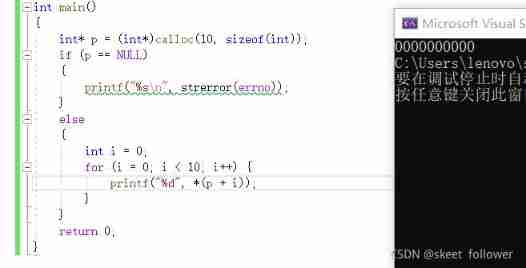
2.3realloc
- realloc Functions make dynamic memory management more flexible .
- Sometimes we find that the application space is too small in the past , Sometimes we think the application space is too large , That's for reasonable time memory , We will make flexible adjustments to the size of memory . that realloc Function can be used to adjust the dynamic memory size . The function prototype as follows :void* realloc (void* ptr, size_t size);
- ptr Is the memory address to be adjusted ,size New size after adjustment , The return value is the starting memory position after adjustment .
- This function adjusts the size of the original memory space , The original data in memory will also be moved to new Space .
#include<stdio.h>
#include<stdlib.h>
int main()
{
// Apply to memory 10 An integer space
int* p = (int*)malloc(20);//int* Force type to integer
if (p == NULL) {
// Failed to open up space , The reason for the printing error
printf("%s\n", strerror(errno));
}
else {
// Normal use space
int i = 0;
for (i = 0; i < 10; i++) {
*(p + i) = i;
}
}
int* ptr = realloc(p, 40);
if (ptr != NULL) {
p = ptr;
int i = 0;
for (i = 5; i < 10; i++) {
*(p + i) = i;
}
for (i = 0; i < 10; i++) {
printf("%d", *(p + i));
}
}
free(p);
p = NULL;
return 0;
}
3. Common dynamic memory errors
- Yes NULL Dereference operation of pointer
#include<stdio.h>
#include<stdlib.h>
int main()
{
int* p = (int*)malloc(40);
int i = 0;
for (i = 0; i < 10; i++)
{
*(p + i) = i;
}
free(p);
p = NULL;
return 0;
}In case malloc Failed to open up space , be p Will be assigned a null pointer , therefore malloc When using, you must judge whether the return value is a null pointer .
- Cross border access to dynamic open space
#include<stdio.h>
#include<stdlib.h>
int main()
{
int* p = (int*)malloc(5 * sizeof(int));
if (p == NULL) {
return 0;
}
else {
int i = 0;
for (i = 0; i < 10; i++) {
*(p + i) = i;
}
}
free(p);
p = NULL;
return 0;
}
malloc Only opened up 5 An integer element , and for Loop access 10 Caused cross-border visits , Program crash .
- Use of non dynamic memory free Release
#include<stdio.h>
#include<stdlib.h>
int main()
{
int a = 10;
int* p = &a;
*p = 20;
free(p);
return 0;
}
- Use free Release a piece of dynamic memory
#include<stdio.h>
#include<stdlib.h>
int main()
{
int* p = (int*)malloc(40);
if (p == NULL) {
return 0;
}
else {
int i = 0;
for (i = 0; i < 10; i++) {
*p++ = i;
}
}
free(p);
p = NULL;
return 0;
}
p Changes have taken place in this process , It is not our complete development space , If you want to release, you can only release it from the starting position of the opening , So wrong .
- Multiple releases of the same dynamic memory
void test()
{
int *p = (int *)malloc(100);
free(p);
free(p);// Repeat release
}- Dynamic memory forget to release ( Memory leak )
void test()
{
int *p = (int *)malloc(100);
if(NULL != p)
{
*p = 20;
}
}
int main()
{
test();
while(1);
}No space is released after use , Will continue to consume memory , It may cause the server to crash .
4. Flexible array
4.1 Concept of flexible array
Maybe you've never heard of Flexible array (flflexible array) The concept , But it does exist . C99 in , The most in the structureThe latter element is allowed to be an array of unknown size , This is called 『 Flexible array 』 member
The code is as follows :
typedef struct st_type
{
int i;
int a[];// Flexible array members
}type_a;4.2 The characteristics of flexible arrays
- A flexible array member in a structure must be preceded by at least one other member .
- sizeof The size of the structure returned does not include the memory of the flexible array .
- Structures that contain flexible array members use malloc () Function to dynamically allocate memory , And the allocated memory should be larger than the size of the structure , Adapt to Expected size of the flexible array .
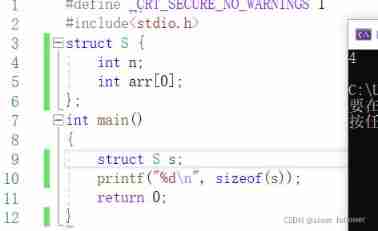
4.3 The use of flexible arrays
Code 1:
#include<stdio.h>
struct S {
int n;
int arr[0];
};
int main()
{
struct S* s = (struct S*)malloc(sizeof(struct S) + 5 * sizeof(int));
int i = 0;
for (i = 0; i < 5; i++) {
s->arr[i] = i;
}
struct S* ps = realloc(s, 44);
if (ps!= NULL) {
s = ps;
for (i = 5; i < 10; i++) {
s->arr[i] = i;
}
}
for (i = 0; i < 10; i++) {
printf("%d", s->arr[i]);
}
free(s);
s = NULL;
return 0;
}Code 2:
#include<stdio.h>
struct S {
int n;
int* arr;
};
int main()
{
struct S* ps = (struct S*)malloc(sizeof(struct S) + 5 * sizeof(int));
ps->arr = malloc(5 * sizeof(int));
int i = 0;
for (i = 0; i < 5; i++) {
ps->arr[i] = i;
}
for (i = 0; i < 5; i++) {
printf("%d\n", ps->arr[i]);
}
int* ptr = realloc(ps->arr, 10 * sizeof(int));
if (ptr!= NULL) {
ps->arr = ptr;
for (i = 5; i < 10; i++) {
ps->arr[i] = i;
}
}
for (i = 0; i < 10; i++) {
printf("%d ", ps->arr[i]);
}
free(ps->arr);
free(ps);
ps = NULL;
return 0;
}4.4 Advantages of flexible arrays
By comparing the above code 1 And code 2, Code 1 The implementation of has two benefits :
1. Convenient memory release
2. Conducive to access speed
边栏推荐
- Multilingual Wikipedia website source code development part II
- Write a jison parser from scratch (2/10): learn the correct posture of the parser generator parser generator
- Write a mobile date selector component by yourself
- What are the advantages of automation?
- Fabric of kubernetes CNI plug-in
- Hands on deep learning (36) -- language model and data set
- 2022-2028 global strain gauge pressure sensor industry research and trend analysis report
- Report on investment analysis and prospect trend prediction of China's MOCVD industry Ⓤ 2022 ~ 2028
- Write a jison parser from scratch (1/10):jison, not JSON
- PHP personal album management system source code, realizes album classification and album grouping, as well as album image management. The database adopts Mysql to realize the login and registration f
猜你喜欢

2022-2028 global elastic strain sensor industry research and trend analysis report

Regular expression (I)
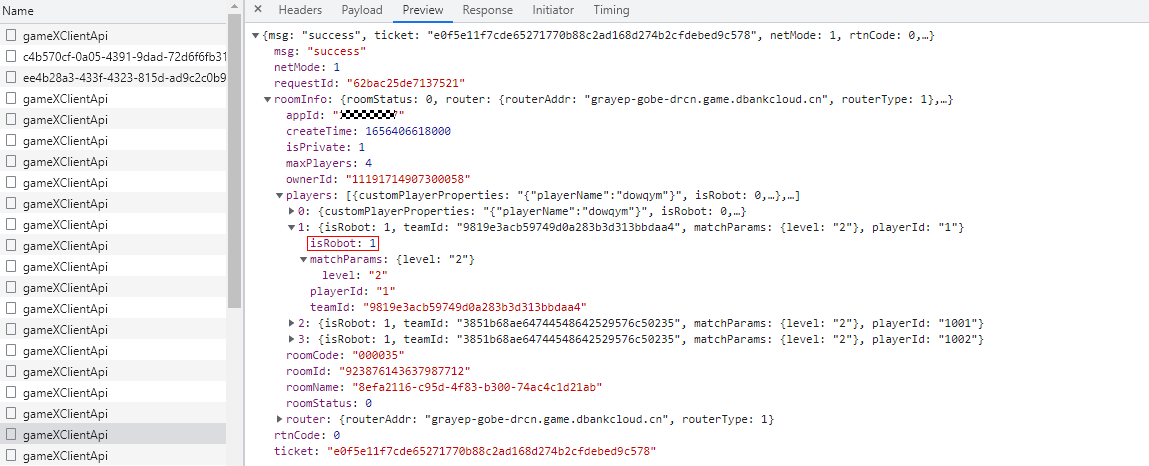
How can Huawei online match improve the success rate of player matching
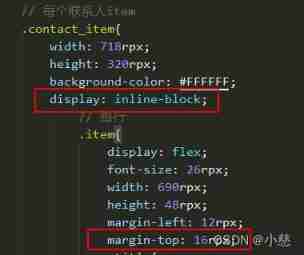
The child container margin top acts on the parent container
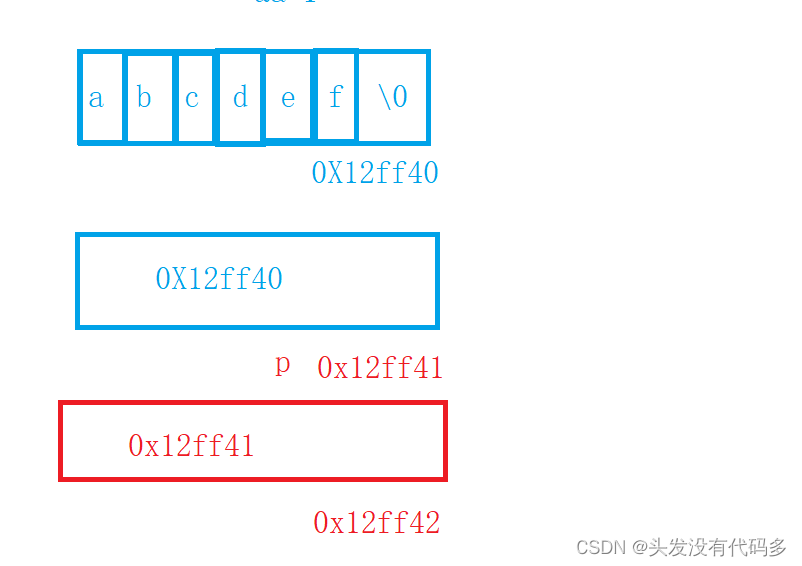
C语言指针经典面试题——第一弹
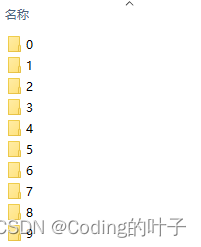
mmclassification 标注文件生成
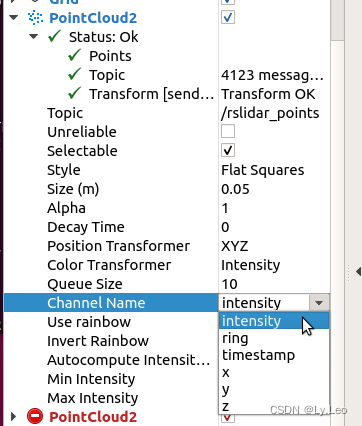
Pcl:: fromrosmsg alarm failed to find match for field 'intensity'
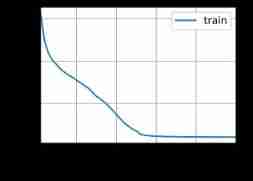
Hands on deep learning (39) -- gating cycle unit Gru

C # use gdi+ to add text with center rotation (arbitrary angle)

Daughter love in lunch box
随机推荐
Write a jison parser from scratch (4/10): detailed explanation of the syntax format of the jison parser generator
Logstack configuration details -- elasticstack (elk) work notes 020
C语言指针经典面试题——第一弹
Write a jison parser from scratch (3/10): a good beginning is half the success -- "politics" (Aristotle)
Write a jison parser (7/10) from scratch: the iterative development process of the parser generator 'parser generator'
Hands on deep learning (39) -- gating cycle unit Gru
Normal vector point cloud rotation
Lauchpad X | 模式
2022-2028 global elastic strain sensor industry research and trend analysis report
DR6018-CP01-wifi6-Qualcomm-IPQ6010-IPQ6018-FAMILY-2T2R-2.5G-ETH-port-CP01-802-11AX-MU-MIMO-OFDMA
C语言指针面试题——第二弹
法向量点云旋转
PHP personal album management system source code, realizes album classification and album grouping, as well as album image management. The database adopts Mysql to realize the login and registration f
Svg image quoted from CodeChina
2022-2028 global seeder industry research and trend analysis report
Hands on deep learning (37) -- cyclic neural network
pcl::fromROSMsg报警告Failed to find match for field ‘intensity‘.
libmysqlclient.so.20: cannot open shared object file: No such file or directory
lolcat
PHP is used to add, modify and delete movie information, which is divided into foreground management and background management. Foreground users can browse information and post messages, and backgroun